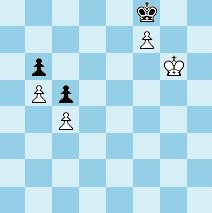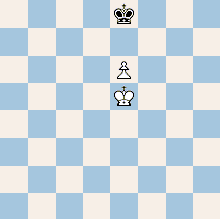
Kg6-f6! 1-0

Kg6-f6! 1-0
The only difference between Stalemate Chess and regular chess is
that stalemating the opponent wins the game, but only in case an
enemy pawn is positioned ahead of the enemy king, on the seventh rank. Stalemate is only
a win if the king is blocked by an enemy pawn on the seventh rank.
(Thus, the stalemated party could have additional pawns and pieces on the
board, provided that they are blocked or pinned.) This means that all non-trivial K +
P versus K endgames are won. However, stalemate still counts as draw in
all other situations. Thus, many interesting qualities connected with
stalemate are retained. Comparatively, in Chinese Chess (Xiangqi) stalemate is always a win. It is a logical enhancement of the chess rules because it merely means that we add a special capability of the pawn. Only this figure can win by stalemating on the 7th. Comparatively, only the king has the special capability of performing the castle move.
 Unlike in regular chess, this position is won regardless who moves.
Unlike in regular chess, this position is won regardless who moves.
See also Frog King Chess, Sentry Chess, Reformed Chess, Revised Chess, Dynamic Chess, Valiant Chess and Improved Chess.
☛ You can download my free Stalemate Chess program here, but you must own the software Zillions of Games to be able to run it.
☛ Don't miss my other chess variants.
© Mats Winther (September 2014).